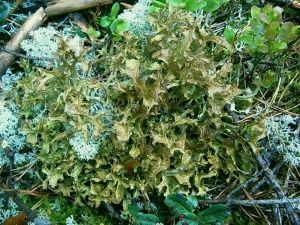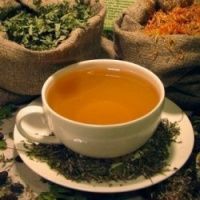 Icelandic moss is a common lichen of the Parmelian family, whose body is represented by a layered structure attached to the ground or tree bark.
Icelandic moss is a common lichen of the Parmelian family, whose body is represented by a layered structure attached to the ground or tree bark.
The plant grows up to ten centimeters tall. Icelandic moss is specifically colored: on top it is greenish, and below - light brown.
Icelandic moss grows mainly in the temperate climatic zone of North America and Europe. His homeland is, undoubtedly, Iceland.
The thallus of moss is abundant on the slopes of this island. Also, the plant is very common in Asia, Australia and Africa. In our country moss grows well on the Crimean peninsula and the Caucasus. Lichen grows in sunny meadows in the forest, tundra, forest-tundra, on the swamp. The wide application of Icelandic moss in folk medicine is explained by its unique useful properties.
Preparation of raw materials
The basis for the production of medicines from Icelandic moss is the lichen thallus. Collect moss with rakes or just hands, clean the impurities of needles and earth and dry in the fresh air or in a well-ventilated room. Direct sunlight falling on the plant does not spoil it, but it contributes to the rapid destruction of the beneficial properties of the lichen.
After completion of the first drying, the lichen is again peeled, it is cleaned of the remaining impurities, dried for a while and then put in sacks or wooden containers.
Shelf life of raw materials for preparation of a medicinal product is two years. After its expiration, Icelandic moss can not be used.
Raw materials are usually harvested in late summer or early autumn.
Useful properties of the plant and its use
Healing properties of
Icelandic moss contains:
- organic acids with a pronounced antibacterial effect;
- sodium sulphate is an excellent remedy for tuberculosis infection;
- enzymes;
- substances that enhance immunity;
- iodine, iron, manganese, copper, titanium and other microelements;
- vitamins;
- odorous substances;
- bitterness, increasing appetite and stimulating digestion;
- mucus, eliminating the inflammatory process in the pharynx, nose and mouth, stomach and intestines.
More information on the medicinal properties of the plant and its medical significance can be found in the article: Icelandic moss is useful for everyone. It heals the intestines without any interference!
Application of
Thanks to the above structural components, Icelandic moss is used to treat cough, and also to rinse throat and mouth cavity in tonsillitis, pharyngitis, and angina.
- Iceland moss is an effective cough remedy. A tea mixture prepared on the basis of Icelandic moss is actively used to treat such a dangerous childhood illness as whooping cough.
- Icelandic moss is an anti-emetic. Preparations from this plant treat almost any pathology of the digestive system. To treat a number of diseases, different parts of the plant are used.
- This plant well helps to cope with dystrophy and general exhaustion of the body.
- Icelandic tea is used for skin diseases, for example, for the treatment of acne and acne. Also, the regular use of this plant in the form of tea and compresses helps to fight with burns, intertrigo, skin infections and infected wounds.
- As part of the fees lichen effectively relieves pain in the chest or epigastrium.
- The broth of Icelandic moss helps with constipation and diarrhea. This curative effect is associated with the formation during the cooking plant mucus, enveloping the stomach.
- Syrup with Icelandic moss is used as a restorative in the period of reconvalescence to restore the body's strength after illness.
- Due to its astringent properties and tannins, Icelandic moss performs a detoxification function for poisoning with salts of heavy metals and poisons of plant origin.
Recipes for Traditional Medicine
-
 With pertussis, Icelandic moss tea is used. How to brew it right?
With pertussis, Icelandic moss tea is used. How to brew it right?
For this, take half a teaspoon of thyme and the same amount of moss and pour a glass of boiling water. Leave to infuse for five minutes, filter and drink this tea one cup three times a day. - With a stomach ulcer, a decoction prepared from Icelandic moss, althea root and flax seeds helps. Take a tablespoon of this collection and pour it with boiling water. They put on a weak fire, boiled for seven minutes, removed from the fire and filtered. Take the resulting broth seventy milliliters before meals five times a day.
- To prepare the tincture take forty grams of moss, pour them a glass of diluted to sixty degrees of alcohol and leave to infuse for a week. The received tincture is taken ten drops three times a day.
Indications for use are: diarrhea, anorexia, cough with asthma attacks and some inflammatory diseases of the digestive system.
- For the treatment of pulmonary tuberculosis Icelandic moss is brewed in a special way. Pour four tablespoons of moss half a liter of cool boiled water and put on a weak fire for five minutes. Take a cool broth in small sips three times a day.
- Icelandic moss helps to get rid of cough for children with bronchitis. In enameled dishes pour a glass of milk and add there a tablespoon of chopped moss. The capacity is put on the fire for thirty minutes, closing the lid. Give this medicine to children before going to bed in a hot form.
- To stimulate the motor activity of the musculature of the gastrointestinal tract and fight against atony of the stomach or intestine, prepare a decoction of three tablespoons of moss and a liter of water. After a half-hour boil in a water bath, a viscous mass is obtained, which is consumed all in one day.
- Vitamin jelly, prepared from Icelandic moss, is taken as a general restorative, stimulating immunity and eliminating anemia. To get rid of the characteristic bitterness thallus plants are placed in a bucket, filled with water with the addition of soda, stand for 24 hours, washed and put in clean water for four hours. Soaked and washed raw materials are cut into small pieces, boiled, filtered. The resulting viscous liquid is mixed with sugar and berries, cooked until ready, then served on a table and used as a regular kissel.
- Treatment of purulent wounds and furuncles with Icelandic moss is carried out with lotions, bandages, wraps and compresses, which are made from water prepared and filtered by decoction. Change such bandages three times a day.
